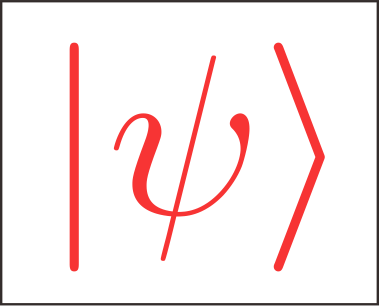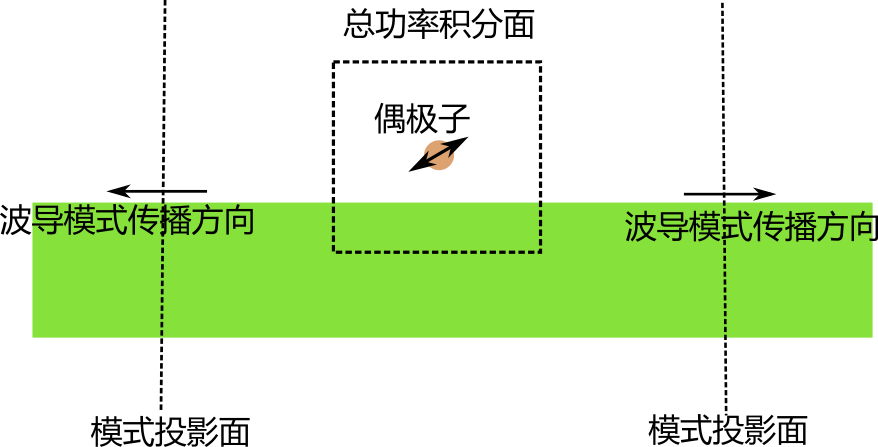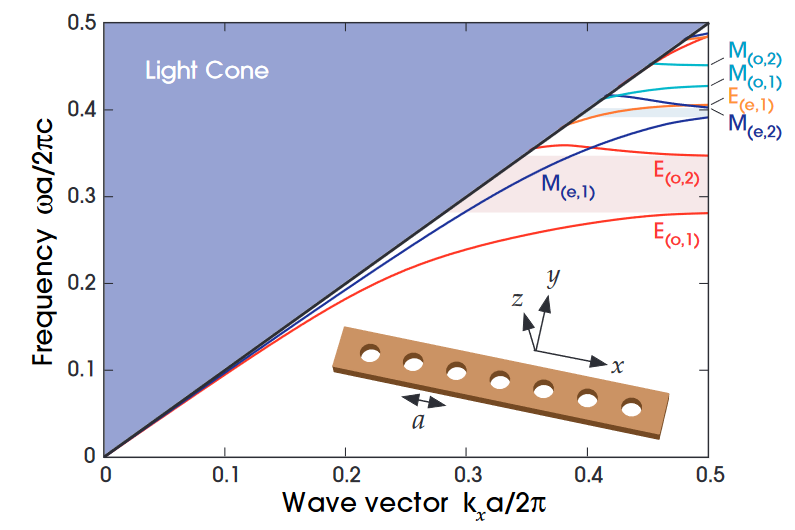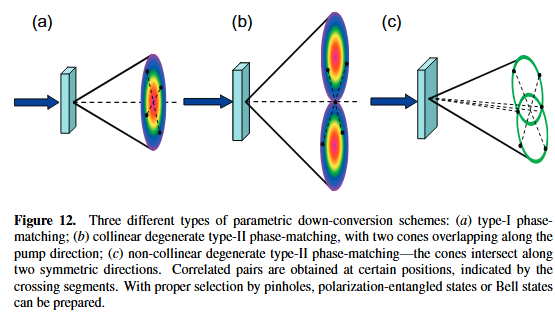Meep教程(4) MPB计算光子晶体能带
Meep
说明
回归科研以后,一些爱好需要重新拾取起来了。最近学会了用COMSOL计算光子晶体能带,现在尝试来用Meep计算光子晶体能带,希望可以以后有机会作为主力的程序来使用。
我主要参考的是官方文档:https://mpb.readthedocs.io/en/latest/Python_Tutorial/
简单二维光子晶体能带例子
能带计算
本次主要想重复书籍Photonic Crystals: Molding the Flow of Light second edition 第五章的结构的能带计算: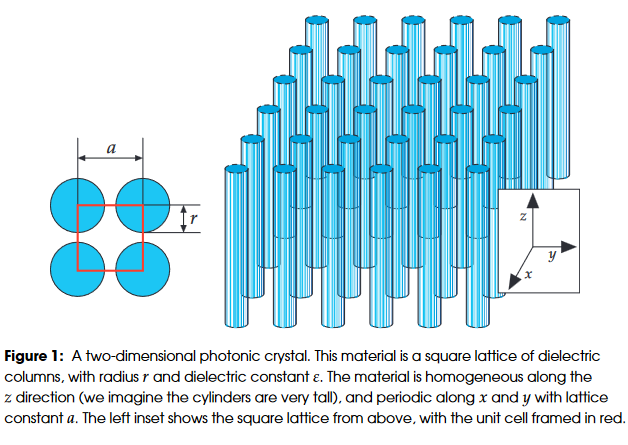
按照官方文档的介绍,直接设置结构,计算相应能带即可,具体可以看代码和注释1
2
3
4
5
6
7
8
9
10
11
12
13
14
15
16
17
18
19
20
21
22
23
24
25
26
27
28
29
30
31
32
33import math
import meep as mp
from meep import mpb
num_bands = 8
# 定义好扫描的k波矢
k_points = [mp.Vector3(), # Gamma
mp.Vector3(0.5), # X
mp.Vector3(0.5, 0.5), # M
mp.Vector3()] # Gamma
# 对k波矢进行插值
k_points = mp.interpolate(20, k_points)
# 基本结构和材料性质
geometry = [mp.Cylinder(0.2, material=mp.Medium(epsilon=8.9))]
# 基本二维cell
geometry_lattice = mp.Lattice(size=mp.Vector3(1, 1))
resolution = 32
# mode solver设置
ms = mpb.ModeSolver(num_bands=num_bands,
k_points=k_points,
geometry=geometry,
geometry_lattice=geometry_lattice,
resolution=resolution)
# 计算te模式
print("Square lattice of rods: TE bands")
ms.run_te()
按照官方文档说法,要查看得到的本振频率,需要从输出的类似的log文件中提取,比如:
1 | tefreqs:, 13, 0.3, 0.3, 0, 0.424264, 0.372604, 0.540287, 0.644083, 0.81406, 0.828135, 0.890673, 1.01328, 1.1124 |
我们需要手动将这些信息提取出来,在Linux里面主要通过正则表达式提取,这种方式感觉太不优雅了,官方文章还有例子MPBData:
1 | tm_freqs = ms.all_freqs |
所以可以直接从ms中提取结果1
2
3
4
5
6ms.run_te()
te_freqs = ms.all_freqs
te_gaps = ms.gap_list
ms.run_tm()
tm_freqs = ms.all_freqs
tm_gaps = ms.gap_list
可以将能带绘制出来1
2
3
4
5
6
7
8
9
10
11
12
13
14
15
16
17
18
19
20
21
22
23
24
25
26
27
28
29import matplotlib.pyplot as plt
numk,tmp=np.shape(te_freqs)
klist=range(numk)
fig,ax=plt.subplots()
x = range(len(tm_freqs))
for l in range(num_bands):
plt.plot(te_freqs[:,l],'r-')
plt.plot(tm_freqs[:,l],'b-')
plt.ylim([0,0.8])
plt.ylabel('$\omega a/(2\pi c)$')
# Plot gaps
for gap in tm_gaps:
if gap[0] > 1:
ax.fill_between(x, gap[1], gap[2], color='blue', alpha=0.2)
for gap in te_gaps:
if gap[0] > 1:
ax.fill_between(x, gap[1], gap[2], color='red', alpha=0.2)
points_in_between = (len(tm_freqs) - 4) / 3
tick_locs = [i*points_in_between+i for i in range(4)]
tick_labs = ['Γ', 'X', 'M', 'Γ']
ax.set_xticks(tick_locs)
ax.set_xticklabels(tick_labs, size=16)
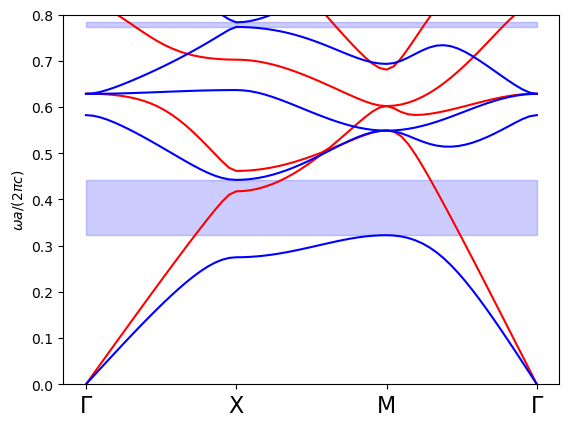
书中的结果是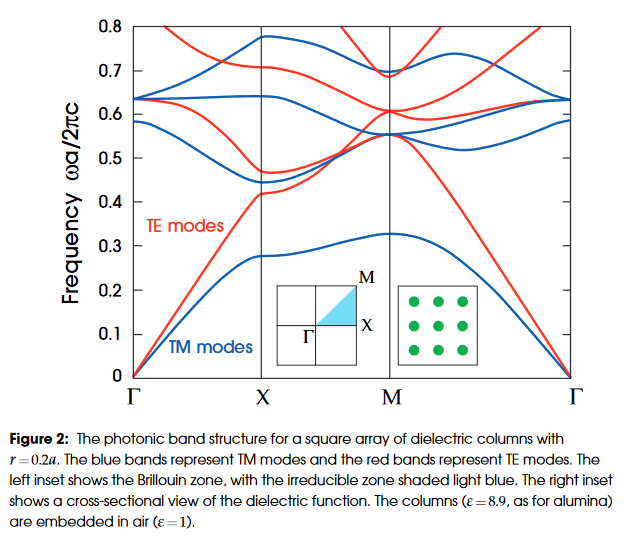
可以看到与书籍的结果是一样的。并且可以比较方便的导出Band Gap,还是比较方便的。
电场导出
以上是能带计算的例子,我们也可以导出相应的电场分布,观察tm模式的Ez,1
2
3
4
5
6efields = []
def get_efields(ms, band):
efields.append(ms.get_efield(band, bloch_phase=True))
ms.run_tm(mpb.output_at_kpoint(mp.Vector3(1/2, 0,0), mpb.fix_efield_phase,
get_efields))
1 | # Create an MPBData instance to transform the efields |
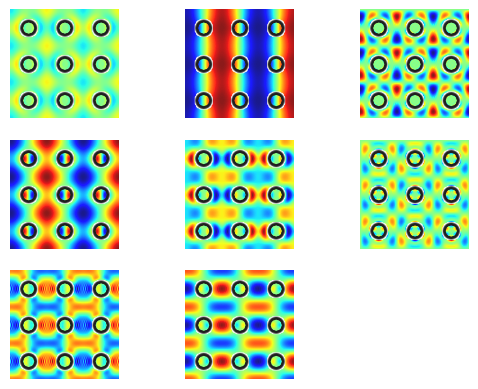
按道理应该没有Ex,Ey分量,可以进行测试,绘制一下Ex
1 | # Create an MPBData instance to transform the efields |
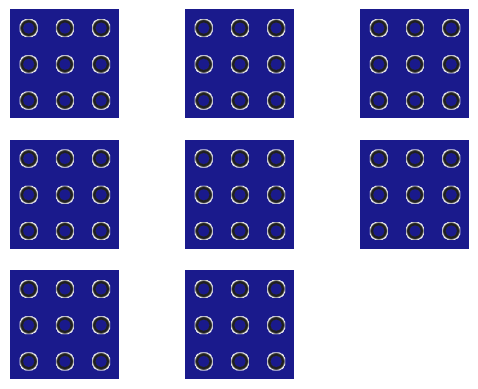
结果与预期一致,都是0。
总结
本次介绍了如何通过MEEP的BPB模块计算二维光子晶体能带,接下来还想实现三种不同的波导的能带计算:
- 二维缺陷波导
- 二维拓扑波导
- 三维纳米梁波导
本次计算的代码可以在我的github中看到。
